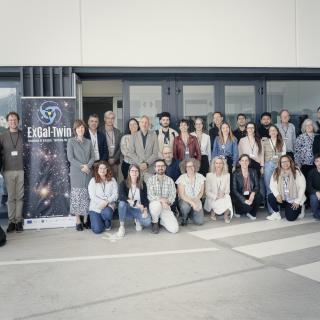The physical processes which suppress the growth of the stellar population in massive galaxies are not clear, although there is considerable agreement about the idea that the feedback winds from galaxies with active nuclei slow down their star formation. Now an international study published in Nature Astronomy, in which the Instituto de Astrofísica de Canarias (IAC) is a participant, suggests that the feedback winds do not have a direct impact on braking the formation of stars in massive galaxies, and attributes the process to other events such as ejection by huge tides caused when galaxies merge.
The rapid accumulation of matter by a supermassive black hole causes the emission of strong jets, winds, and radiation, which are expelled from the centre of the galaxy towards the exterior. Tnis phenomenon of feedback by Active Galactic Nuclei (AGN) has been thought of as a probable way for rapid braking of star formation, because the radiation emitted could eliminate the cold molecular gas clouds aroiund the nucleus which give birth to stars.
In addition, according to accepted theory, different models of galaxy evolution need the injection of energy from the AGN into the interstellar medium to explain the observed properties of massive galaxies, such as the phenomenology of star-formation truncation.
However, the study, in which over 15 scientific institutions have participated, warns about the scarce scientific evidence of cases of massive galaxies whose star formation was truncated abruptly due to feedback winds. In fact, using observations and simulations, the results show that the mechanism which brakes the formation of stars in those galaxies is not due to feedback winds,, but to other extreme mass ejections driven by mergers of galaxies.
The article also suggests that the activity of accretion by the central black holes occurs together with the formation of stars, and that these two phenomena self-regulate during thousands of millions of years. That means that the accretion onto the black holes, and the mechanisms driven by the feeback winds are slow processes, so that it is not likely that they cause the events which truncate star formation rapidly.
The observations are centred on ID2299, a typical galaxy whose star formation is about to switch off (and will remain like that for a long period of time) due to a violent event which has eliminated a major part of its interstellar medium.
“Our observations are tracing an extrem episode, which is unlikely to be consistent with the classical interpretation of a nuclear wind causing feedback” say those responsible for the study.
We don’t question that the feedback outflows play an important role. They are needed, for example, to explain the highest components of velocity in the spectra of galaxies with AGN” notes Shuowen Jin, a researcher at the IAC who has participated in the work. “However their importance may have been overestimated and it would be worth while reconsidering at least part of the literature about these outflows and their general impact on the evolution of the galaxies” adds this astrophysicist, and points out that “ in this study we have shown a new mechanism for the rapid cooling of galaxies: massive tidal ejections”
The difficulty of the work is due to the connection between phenomena on very different timescales and spatial scales, and this is where the IAC contribution comes in, by supplying photometry at multiple wavelengths, and also a catalogue of galaxies produced in 2018 and led by Jin, in which the authors estimated the numerical density of the disruptive events in the early universe.
For this an exhaustive analysis of data has been performed, most of them obtained directly from satellites, and from the Large Atacama Millimetre Array (ALMA) in Chile.
“We have also provided a very useful method for identifying weak residual emission lines, which is very important for a firm confirmation of the broader line of work in this study, and which is the key evidence for massive ejections” adds Shuowen Jin.
Scientific article: Puglisi, A., Daddi, E., Brusa, M. et al. A titanic interstellar medium ejection from a massive starburst galaxy at redshift 1.4. Nat Astron (2021). https://doi.org/10.1038/s41550-020-01268-x. DOI: 10.1038/s41550-020-01268-x
References:
Jin et al. 2018 https://ui.adsabs.harvard.edu/abs/2018ApJ...864...56J/
JIn et al. 2019 https://ui.adsabs.harvard.edu/abs/2019ApJ...887..144J/
Autor principal:
Annagrazia Puglisi
Contacto en el IAC:
Shuowen Jin: sjin [at] iac.es (sjin[at]iac[dot]es)
Caption: HST imaging and narrow and broad components ALMA maps of ID2299. The top-left panel shows the HST-F814W imaging of the source, sampling the UV rest-frame emission from young stars. The top (bottom) rows show the CO(2-1), CO(5-4), [CI](2-1) and CO(7-6) ALMA maps of the narrow (broad) emission. The luminosity of the broad line emission indicates that half of the total molecular gas mass is decoupled from the galaxy.
 and CO(7-6) ALMA maps of the narrow (broad) emission HST imaging and narrow and broad components ALMA maps of ID2299. The top-left panel shows the HST-F814W imaging of the source, sampling the UV rest-frame emission from young stars. The top (bottom) rows show the CO(2-1), CO(5-4), [CI](2-1) and CO(7-6) ALMA maps of the narrow (broad) emission](/sites/default/files/styles/crop_rectangle_21x9_to_1280/public/images/news/nature_210111.png?h=310065c9&itok=yapl3FoK)


